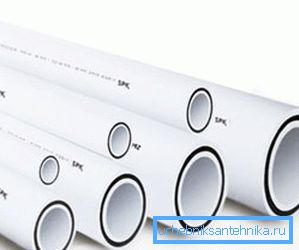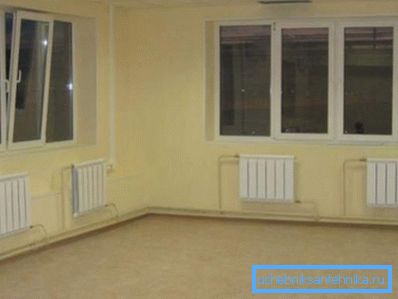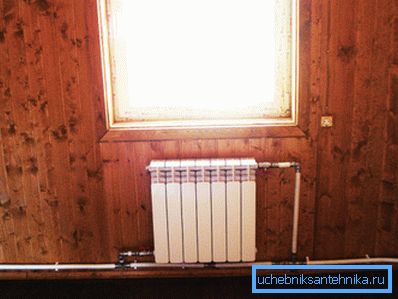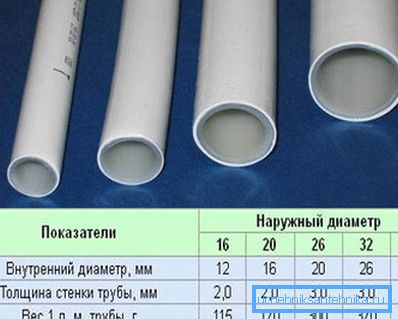The diameter of the pipe for heating and the effect of this
As is known, the work of the heating system depends largely on how well the parameters of all elements are selected. And if proper attention is paid to boilers and radiators, then pipes are often purchased on the basis of “what is cheaper” or “what was at hand.” Meanwhile, the pipelines must comply with certain parameters in order to ensure optimal economical operation of heating utilities.

Main types of pipes
To determine what diameter pipes for the heating system will need, you must first determine the material of manufacture. The most commonly used options are:
| Steel Products | The most widespread option, a few decades ago had no alternatives. The advantages can be attributed to the low price, the disadvantages - the complexity of installation (welding), susceptibility to corrosion and the need for periodic painting |
| Polypropylene pipes | A very popular decision due to several factors: the affordable price, both for the base material and for the heating pipe fittings, corrosion resistance and quick installation. Among the shortcomings, it is necessary to note the high coefficient of thermal expansion and the deformation of highways when exposed to high temperatures |
| Metal pipes for heating | This option is characterized by high strength, corrosion resistance and high quality of installation, since the number of joints is minimal, the system can be placed inside the walls and concreted. Of the minuses should be noted the high cost and the need to use a special tool when working |
| Copper pipelines | This option has a number of advantages and is characterized by durability, high strength and excellent performance, the outer diameter of copper pipes for heating is small, which saves space. Of the minuses, we note a rather slow assembly process (especially if you do everything yourself without the help of specialists) and incompatibility with some materials (an electrolytic process occurs) |
| Stainless steel | One of the best options, with excellent characteristics. Rarely used due to the very high cost and complexity of installation |

How to choose the optimal diameter
It should be noted that there is no universal option suitable for all systems; in each specific case, a number of important factors should be taken into account, which we will consider in more detail and in detail.
Tip! It is not worth listening to incompetent specialists who say that the larger the diameter of the pipeline, the better. First, in large pipes, the pressure is lower, hence the heat transfer is worse, and secondly, it is more difficult to install them, and they take up much more space.

The main advantages of small pipelines
If you have a house heating system with natural circulation, then the correct diameter calculation is very important, since the system efficiency and the correct circulation of the heat carrier will directly depend on this indicator. But it is much more efficient to use a forced system with a circulating pump, it can be used to achieve excellent performance, and the diameters of pipes in the heating system can be much smaller.
But still, too small a section is also not suitable, since this reduces heat transfer, and communications work very noisy. Therefore, it is important to make competent calculations in order to achieve optimal performance. Experts recommend selecting piping with an internal cross section such that the velocity of the fluid is from 0.4 to 0.6 m / s, below is a table with which it is easy to make all the required calculations.

The small diameter of the pipes for heating a private house provides a number of advantages:
- More attractive cost of materials, however, all work can be done independently (if the joints are made using special tools, then the instructions for their use are required to study).
- Small section allows to reduce the rate of circulation of the coolant in the system, ensuring its high efficiency and maximum heat transfer.
- No matter what material you choose, small diameter reduces system capacity., therefore, heating a private house or apartment is much more economical, and the system heats up faster.

Calculation example
To calculate the desired diameter of the heating pipes, you need to consider the following parameters:
- The area of the room, as a rule, with a ceiling height of up to 3 meters and high-quality wall insulation for 10 m2 the area should account for 1 kW of thermal power.
Note! In some regions, the indicator of the required capacity may vary, you can find out all the information in the authorized bodies and special directories.
- For a room of 25 m2 2.5 kW of power plus a margin of 20% is required, therefore the final result will be 3.
- When choosing radiators, they should be selected so as to provide the necessary indicators, while it is better to choose a variant with a margin than products with insufficient characteristics.
- With the help of the above table, the optimum internal diameter is selected, in our case it will be 10 mm, it is allowed to use the 12 mm variant.

Conclusion
In fact, the size of the pipes is very important and affects the operation of the system much more than is commonly believed. You should pay close attention to this issue, the video in this article will help you to understand some nuances.